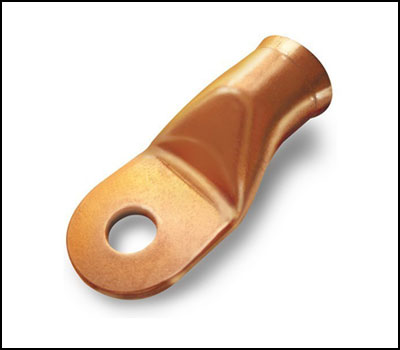This article uncovers basic characteristics of copper and aluminium used in the cable lugs showcasing the merits and demerits of each that can support you in taking a final call at the time of selecting the type of cable lugs to be applied for your specific cabling project. Aluminium proves to be pretty cheaper in cost, but has varied drawback when it comes to durability and reliability. While copper turns out to be highly reliable and durable in terms of security and low maintenance becoming a bit expensive affair. The big dilemma for most of the electrical manufacturers is whether to opt for copper lugs or aluminium lugs? Or Will the cost of rework will end up spending more in case of installing aluminium lugs? Take a read on below content to figure out and trace the exact lead points to be considered at the time of selecting on copper cable lugs or aluminium cable lugs.
Cable lugs also known as copper terminals or crimping lugs form a significant part of an electrical system as one of the reliable conductors used to connect cables together. These mechanical lugs are made of one of the three metals (ie) copper or aluminium or an alloy. When it comes to their functionalities, both the metals have a facsimiled purpose. Only by knowing about their specific application and characteristics, one can get a clear view on which one to opt in to get high security with less maintenance proving it to be a perfect set up for an indoor or outdoor cable protection system.
Aluminium and copper have frequent applications in electrical cabling system as the conductors are rich in features with high conductivity. No doubt these metals have good resistance to corrosion and are ductile but they have different properties that make them a best suit for specific applications. Let’s tour into the reasons for copper being the highly preferred metal of choice for cable lugs in current times.
The key success factor that derives high security and low maintenance by installing copper lugs is related to ‘coefficient of thermal expansion’. High coefficient of thermal expansion results in increased risk of fire. Copper lugs, having low coefficient of thermal expansion, proves to deliver secured installation with high performance mechanism. This is the reason why wiring and cabling system based on copper are now preferred more across the globe. On the other hand, the lure of low price of aluminium lug still fascinates some of the electrical manufacturers to opt for its installation in the cabling system. This is why aluminium cable lugs become first choice back in 1960’s before the trend was switched over to copper lugs.
The researchers have also come up with new innovation in aluminium cable lugs making it safer as the copper lugs.The new model consists of aluminium cable lugs that are coated with copper, creating a hindrance in rusting process and blocks the oxide formation on the surface causing a great derail to catch fire.
Regardless of such improvements and modification in aluminium lugs, the notion of copper lugs being a more suitable choice to get easy and smooth maintenance with high security has still not gone away.One should know some important facts on aluminium lugs before trying to track the reason for increase faith of people on copper lugs.
Aluminium was a vital part of development during the notable innovation happening in the engineering works in early 1960’s. Back then, the aluminium wiring system was of the lavish use in every electrical operation that made the electricians to install aluminium lugs to connect cable junctions. Termination failure was what they had to face that gave rise to the increased level of electrical fires on a frequent basis. After going into the root cause of this problem, researchers detected the formation of aluminium oxide on the surface of mechanical lugs that become the main driver to catch fire. This was the time when copper lugs become the name of the game to arrive as an efficient replacement of aluminium lugs.
The electrical continuity that drives smooth circuitry was achieved through installing copper lugs in the cabling system, marking it as one of the best suitable specification till date. In addition to this, many international quality standards require full tinning of copper conductors before inserting it into the cable lug that is followed by crimping of the cable lug. This made the cable lug to become more tough and strong during short circuit conditions along with high resistance to corrosion and galvanic action.
Surprisingly, the research and development happening across the globe turn up some other findings that show the manufacturers do not use pure aluminium in aluminium lugs. Nickel or copper coating/flashing is what is practised on continuous basis covering it with silver or tin. This proved to be a successful modification avoiding termination failure and electrical fire. Lastly, at the time of selecting the type of crimping lug, one should consider the main purpose of the cabling project along with the sensitive concern of security and the kind of maintenance operations required to get high performance and durable cable lugs that can prove to be tough for specific conditions.
BICC Components Limited (BICC) offers high performance copper terminals (cable lugs) manufactured from seamless copper tube in compliance with BS EN 12449:2012 standards. Other compliance with international quality standards includes the production of cable lugs as per IEC 61238-1 and electro tin conforming according to the standards of BS EN 1872:1984 to give an effective finish to the crimping lugs. Halt on to https://www.bicccomponents.uk.com/copper-terminal/ , to know more about the application, features and technical data about the offered range of cable lugs. To get in touch with one of our team of cable gland experts, visit https://www.bicccomponents.uk.com/contact/ to consult on your project. Feel free to give us a call or drop a mail in case of any queries or to get a quote.
 SUBSCRIBE TO OUR BLOG
SUBSCRIBE TO OUR BLOG
